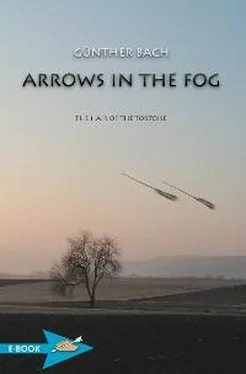Günther Bach - Arrows In The Fog
Здесь есть возможность читать онлайн «Günther Bach - Arrows In The Fog» — ознакомительный отрывок электронной книги совершенно бесплатно, а после прочтения отрывка купить полную версию. В некоторых случаях можно слушать аудио, скачать через торрент в формате fb2 и присутствует краткое содержание. Жанр: unrecognised, на английском языке. Описание произведения, (предисловие) а так же отзывы посетителей доступны на портале библиотеки ЛибКат.
- Название:Arrows In The Fog
- Автор:
- Жанр:
- Год:неизвестен
- ISBN:нет данных
- Рейтинг книги:5 / 5. Голосов: 1
-
Избранное:Добавить в избранное
- Отзывы:
-
Ваша оценка:
- 100
- 1
- 2
- 3
- 4
- 5
Arrows In The Fog: краткое содержание, описание и аннотация
Предлагаем к чтению аннотацию, описание, краткое содержание или предисловие (зависит от того, что написал сам автор книги «Arrows In The Fog»). Если вы не нашли необходимую информацию о книге — напишите в комментариях, мы постараемся отыскать её.
something that you merely know is there?
Rolf thinks that he hears Erhard’s voice saying:
“You must learn to see the invisible clearly!”
In this sequel of the archery novel «The horn of the hare» the story about the two friends continues.
15 years later: Germany is no longer divided and everything has changed, also Bärgers life and his shooting with the bow and arrow.
Arrows In The Fog — читать онлайн ознакомительный отрывок
Ниже представлен текст книги, разбитый по страницам. Система сохранения места последней прочитанной страницы, позволяет с удобством читать онлайн бесплатно книгу «Arrows In The Fog», без необходимости каждый раз заново искать на чём Вы остановились. Поставьте закладку, и сможете в любой момент перейти на страницу, на которой закончили чтение.
Интервал:
Закладка:
The emperor of China, they say, had heard of the master’s great skill. At that time, it was a special honor to receive a commission for a picture from the emperor. The emperor expected that his commission, which wasn’t very different from an imperial order, would be carried out immediately. That didn’t happen. After several weeks, the emperor sent one of his officials to demand the delivery of the picture, but the painter informed him that he needed more time.
When the painting hadn’t been completed after several months, the emperor sent one his ministers to emphasize the urgency of his imperial wishes. Once again, the painter said that he needed more time.
After half a year, the emperor was so angry with the painter that he ordered him to be brought before him to be executed.
This time, the painter invited the emperor’s messenger into his studio, placed a piece of rice paper on a table, prepared his ink, and right before the messenger’s eyes, painted a picture of a rooster in a few minutes that was so life-like, the messenger almost expected to hear it crow.
The emperor’s messenger rolled up the painting that the painter handed him and, as a few minutes no longer mattered, they drank a cup of tea together.
Then the messenger asked why the painter had made the emperor wait half a year for a painting that he could do in a couple of minutes.
The painter answered that he had never had so little time for a painting.
From morning to night, he had done nothing but watch roosters; how they moved when they crowed, when they ate and drank, when they fought, and when they slept.
He did this, he said, until he understood the essence of a rooster as thoroughly as if he had been one himself. Only then, and not one minute sooner, was he able to paint a picture of a rooster worthy of an emperor.
7
They went into the next room.
Bärger’s drawing table was directly in front of a north-facing window that reached from floor to ceiling. He picked up a pile of journals and project folders carelessly, placed then on the floor and then, pushed them under the bed in the corner of the room with his foot.
Jürgen grinned.
“A place for everything,” he said.
Bärger didn’t answer him. He pulled a rolled-up white felt mat out of a cupboard, placed it on the surface of the low drawing table and carefully flattened it. On closer inspection, the felt mat was more gray than white and showed irregular spots ranging from light gray to black. The spots were concentrated on the right side.
He took a flat covered dish from a mobile office cabinet behind him. The dish was black with a dull surface and fine even grain. It reminded Jürgen of a sharpening stone, but the round shape wasn’t right for that. Bärger put the round dish on the table at the place where the spots were thickest.
Next he produced a white porcelain plate with a broad, flat rim. Remnants of dried ink had formed streaky patterns on the bottom with deep black edges, which looked like a thin network of roots. A disorderly meshed pattern of intersecting brush strokes covered the rim of the plate. Bärger placed the plate on the felt mat next to the black abrasive dish.
Carefully, from the bookshelf behind him, he took a cup-shaped bamboo container in which rattled a good dozen brushes of different sizes. Even the brush handles were of bamboo, spotted black from use. The brush hair was either brownish or white, but mostly the color of the felt mat; light gray from long use. Some were short like watercolor brushes; some were thin and almost the length of a finger, others short and thick.
Now Bärger took a flat wooden case the size of a cigar box from the mobile cabinet. When he opened the lid, Jürgen saw a collection of black ink bars, some new, some used. Some were the size and shape of certain brands of granola bars, other were smaller. Most bore stamped labels in relief or gold colored letters. Jürgen thought that he detected a weak pine scent.
The large jam jar full of water, placed next to the plate on the right side of the table, seemed almost trivial amid all these exotic things.
Bärger inspected the working area spread out in front of him and seemed satisfied. He went to another cabinet with three shallow drawers in its lower section, opened the top drawer and, after brief consideration, took a sheet from one of two piles of different size paper.
The sheet seemed to be twice as long as it was wide, and when he placed it lengthwise on the felt mat, it reached all the way back to the top of the working space. He weighed down the top and bottom edges of the sheet with bronze castings of a bamboo shoot.
Unnoticed by Bärger, Jürgen had gone back into the living room. He poured himself another glass of wine and returned with one of the folding armchairs. He set it up behind Bärger, not too close, but where he could watch the sheet of paper spread out on the drawing table. He sat down silently with a feeling that he should no longer interrupt.
In the meantime, the evening twilight had grown darker and Bärger turned on the drawing lamp over the table. Both men blinked for a moment when the lamp threw a bright circle on the light surface and at the same time the pale traces of the last of the daylight vanished from the window, now an unrelieved black.
For a while, nothing happened.
Bärger seemed to be looking at the calligraphic inscription that hung above his working area. There were four large black symbols under each other, heavy black on coarse paper, painted very hastily with a broad brush; or so it seemed to Jürgen. But Bärger wasn’t really looking at the symbols, but at something else, something somewhere beyond them.
Jürgen cleared his throat carefully.
Then he asked, “Is that really rice paper?”
Bärger didn’t seem to hear him. He didn’t answer, but instead took one of the white brushes from the bamboo cup and used it to drip a little water into the round, black dish in front of him. He picked up a bar of ink and, holding it in his fist like a knife, began to rub the ink, applying considerable force. He rubbed it in steady circular motions, occasionally adding a little water. The bottom of the dish began to fill with a dark black, shiny ink, and a strong pine scent spread through the room.
Finally, Bärger seemed to have enough. He placed the ink bar to one side, carefully selected a brush with long brownish hair and dipped it deeply into the jar full of water. Then he squeezed out the water over the plate with his thumb and forefinger, and dipped the now almost dry brush into the ink dish and let a couple of drops fall onto the plate.
Slowly, carefully, and using only the point of the brush, he mixed the water and ink. The glistening grey color of a storm cloud spread across the bottom of the plate. He added a little water once, which lightened the gray unnoticeably. Finally, after drawing some quick lines on a small sample piece of rice paper, he seemed to be satisfied. Then he turned back to the piece of paper in front of him.
Jürgen watched him carefully.
Bärger seemed to be totally focused and at the same time completely relaxed. He projected a feeling of immense confidence as he sat, the right elbow supported on the table, the brush loose in his hand. It seemed as if he were waiting for a signal that would be given to him by the blank sheet of paper.
Abruptly, Bärger dipped the brush in the water jar and lightly drew it down a linen cloth, which had been folded several times, to remove excess water. Then he rolled the brush across the flat rim of the plate with a circular motion to pick up a little of the rain cloud gray ink mixture. Finally, he dipped the point of the brush into the shiny black in the rubbing dish.
Читать дальшеИнтервал:
Закладка:
Похожие книги на «Arrows In The Fog»
Представляем Вашему вниманию похожие книги на «Arrows In The Fog» списком для выбора. Мы отобрали схожую по названию и смыслу литературу в надежде предоставить читателям больше вариантов отыскать новые, интересные, ещё непрочитанные произведения.
Обсуждение, отзывы о книге «Arrows In The Fog» и просто собственные мнения читателей. Оставьте ваши комментарии, напишите, что Вы думаете о произведении, его смысле или главных героях. Укажите что конкретно понравилось, а что нет, и почему Вы так считаете.









